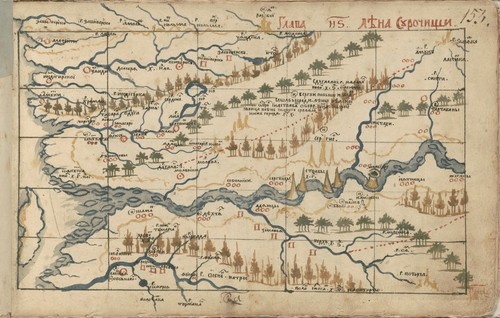Dr. Erika Monahan (New Mexico), “By Ski, Boat, Horse, Dog, Sled, Foot, or Camel: Mapping Travel, Revealing Environment”
Oberseminar zur Geschichte Russlands und Ostmitteleuropas in der Vormoderne
12.05.2022 14:00 Uhr – 16:00 Uhr

Bildquelle: Harvard University, Houghton Library, 100016308_8045854-METS
The environment is simultaneously perpetually invoked and insufficiently integrated into histories of Russia. The connection between climate and national character and prosperity have been long-running sidebar in historical thought. The environment, along with Russia’s vast space, are repeatedly blamed for Russian backwardness. Yet, despite frequent assertion—outside of the particulars of military campaigns the most famous of which would be Napoleon’s ill-fated retreat—the robust demonstration of environmental causality in historical developments in Russia is much harder to come by. Common sense suggests that space and environment in the development of environmental histories is uncontestable, but in particular in the case of Russia, incorporating these phenomena into historical interpretations is in its early stages.
Nowhere is this more true than in the history of Siberia, where the cold, forbidding north and interminable spaces dominate associations. This land where the rivers so unluckily flow north is synonymous with vast space and harsh environment. In fact, Siberian rivers flowed in various directions, but admittedly, not southward into ocean-linked warm waters. Indeed, the characterization is not quite caricature—there is too much validity to dismiss it outright—but it is a cliché. Yet, beyond cliched invocations, the environment remains an under examined edifice in histories of Siberia, Russia’s largest imperial possession. Thanks to the Chorography of Semen Remezov, a remarkable atlas of Siberia, scholars of today have an under-utilized source with which to explore environmental history.
This rich source was a product of imperial prerogatives. It has hybrid purposes, but the one function that is most consistently serves is that of travel. Travel happened for various purposes—to facilitate trade, the transport of people and goods, to collect tribute from Siberian natives. With respect to environmental history, it was the need to describe travel routes, as I see it, that yields in this source the most abundant information/insight into Siberia’s environment centuries ago. This talk focuses on one specific aspect: the environmental information revealed in the fulfillment of the imperial prerogative of establishing travel information. Just as Richard White wrote about knowing the environment through labor, people learned about the environment, how it varied, and what was required to move through it via the work of travel. I argue that the atlas offers a portal into imperial prerogatives and conveys information about the environment of Siberia centuries ago.
Die Veranstaltung wird über Zoom abgehalten.
Anmeldung bei Leonie Zinth L.Zinth@campus.lmu.de

